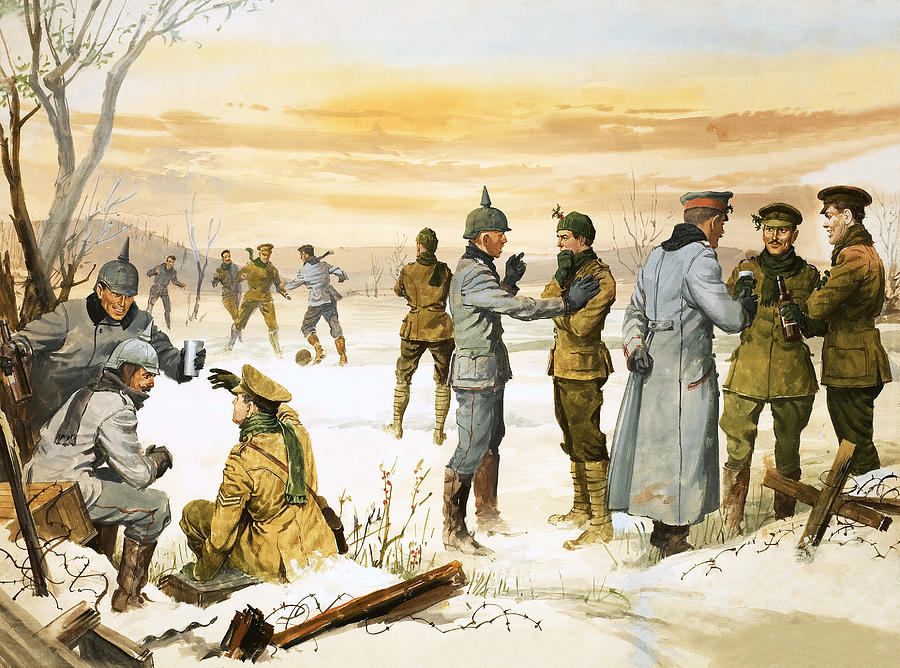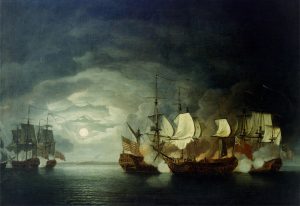The chilling cold was inescapable and constant along the trenches. This was only worsened by the rain-water flooding the muddy walls and floors. Some months had passed since the beginning of World War I, and it was now December of the year 1914. Being “home by Christmas” was out of the question, and a seemingly insuperable stalemate had been reached along the trenches stretching from the Alps to the English channel. The area between these trenches is what was known as “No Man’s Land.” This name was not a novelty in history, but it certainly increased in accuracy since its first usage. Soldiers, young men sometimes as young as fifteen, were dying by the thousands, killed by the indiscriminate fire of the machine gun, a recent addition to the arsenal of armies.1
The Allied Forces had just held off the invading German army along the Marne river, in what was called the “Miracle of the Marne.” The allied victory here signified the failure of the “Schlieffen Plan,” Germany’s attempt at sweeping a 180-degree rotation through neighboring Belgium and France. This strategy would require German troops to rapidly defeat French forces, so that they could be speedily transported via train to what would be the Eastern Front, where Russia would hopefully be slow to mobilize.2

The first trenches were dug on the western front immediately after the Battle of the Marne, which ended on September 12, 1914. The trenches were dug to survive the incoming attacks more easily. However, these trenches would later mark the border into a place of almost certain death.3 The battles of Verdun, the Somme, the Hundred Day Offensive, and Spring Offensive, fought on the Western Front, ended the lives of 5.5 million men. Sixty thousand British soldiers died on the first day of the Battle of the Somme, a death-count still unparalleled in British military history.4
The time in between battles in the trenches was miserable. The 700-kilometer system of parallel trenches was infested with rats, lice, and the bodies of dead horses and men, whom they would stop burying, because the count was so high and because they simply could not reach the bodies without a high risk of losing their own lives in the process. Crosses scattered around the trenches marked the resting places of fallen men, and also provided a grim reminder of the brutality they faced. These insane living conditions led to death by diseases such as dysentery, typhus, or cholera. This place could easily be likened to Hell on Earth. The area between trenches supported this description, a wasteland of barbed wire and tree trunks with no branches.5 Day and night, this is what the men at the front would experience. In fact, the German Expressionist Otto Dix described the trenches eloquently:
“Lice, rats, barbed wire, fleas, shells, bombs, underground caves, corpses, blood, liquor, mice, cats, artillery, filth, bullets, mortars, fire, steel: That is what war is. It is the work of the devil.”6
But then came December. A different feeling was noticeable and written about by the men in the trenches. Sniping had grown rarer, and both French and British soldiers could occasionally hear sentimental singing from the German trenches. Naturally the higher ups thought this to be some sort of tactic by the Germans. Lit up trees would appear, and shortly after, singing would ensue. The French and British soldiers were baffled, because Germans were supposed to be “barbarians.” The Christmas trees that would appear in the not so distant German trenches were somewhat of a novelty to French and British soldiers. However, they were part and parcel of the German Christmas that year.7 Some of the British soldiers shot at the Christmas trees at first, not knowing what to expect. Imagine that after shooting several times at targets near the Germans, they start calling out, promising not to shoot. After months at war, this would not make any sense to war-hardened soldiers.8
A literal calm came on the 4th of December, when an absence of gunfire was reported in some locations. The next day, a royal engineer by the name of Andrew Todd wrote to the Edinburgh Scotsman that soldiers were being “pally” with the enemy. He described their interactions, which included playful cursing at each other, and tossing newspapers from one side to the other, in places separated by only sixty yards. In a card to his mother, one rifleman wrote about how the Germans had peacefully come up and collected some of their wounded, and the British quickly went and collected their own, and after talking, both sides decided to help in burying each other’s dead. The rifleman went on to describe the enemy soldiers as “fine men.” These interactions only increased the closer they got to Christmas. By December 20, both Allied forces and Germans were intent on celebrating Christmas. In preparation of a gift exchange, British forces prepared to give brass boxes, which had been given to them by the crown. These boxes contained cigarettes and pipe tobacco, as well as a greeting card that read “May God protect and bring you home safe.” The Germans, on the other hand, provided some musical entertainment, cigars, and beer imported from as far away as Munich. In a semi-official report, Major Jeffreys provided a description of “A Christmas Onslaught onto the Field-Grey (troops)” as follows:
“Yesterday about Four-o’clock in the afternoon there was a fierce and terrible onslaught of Christmas packages onto our trenches. No man was spared. However, not a single package fell into the hands of the French. In the confusion, one soldier suffered the impaling of a salami two inches in diameter straight into his stomach…. Another had two large raisins from an exploding pastry fly directly into his eyes…. A third man had the great misfortune of having a full bottle of cognac fly into his mouth.”9
Enemies were “fraternizing” with each other. Men who had been killing each other the previous four months, living in disease-riddled trenches, were singing together, playing soccer, getting drunk, throwing down their guns and smoking a cigar or two.10 The Brits sang ‘cheeky’ songs, eventually followed by Christmas carols, and “God save the King,” and the Germans sometimes sang too, accompanied by musical instruments.11 Christmas trees adorned the trenches, and a true spirit of Christmas had possessed these men, a true miracle really.
But the year was 1914, and the war would last until 1918. The continuation of the war would eventually return, because of people like Captain Rudolf Binding, a Hussar who in a letter complained to his father that if he were in power, Christmas would be banned for the year. Measures taken to resume the war, included the banning of future fraternizations with the enemy and an increased pressure on generals to end the peace, in some cases by making the men believe that the truce was part of a nefarious plan by the enemy. This eventually led to more killing, however, in a less eager manner.12 Upon the setting of the sun on Christmas day, one soldier in St. Yvon, twenty-six-year-old Lieutenant Charles Bruce Bairnsfather described a feeling that “It was just the sort of day for peace to be declared.” He talked about wishing that a telegraph boy would reach him with a letter from the King telling the troops that the war is off, and to go back home.13 That day did not come soon.
It is important to note that this truce was informal, and did not only include a single truce but several throughout the trenches. It is said that one similar, yet much less enthusiastic truce was struck in 1915. However, by that time, the propaganda on the barbarity of the Germans had been spread more aggressively.14 There was peace, but not only peace. In one of the most inhumane wars in history, individual men crossed the place called “No man’s land” and shook their enemy’s hand. They complained about the damn war, and wished each other a Merry Christmas.

- Stanley Weintraub, Silent Night (Free Press, 2001), 9; John Keenan, An Illustrated History of the First World War (Alfred A Knopf, 2001), 170. ↵
- Terrence M. Holmes, Absolute Numbers: The Schlieffen Plan as a Critique of German Strategy in 1914 (Sage Publications, Ltd. 2014), 197-199. ↵
- John Keenan, An Illustrated History of the First World War (Alfred A Knopf, 2001), 180. ↵
- The Oxford Companion to British History, 3 Apr. 2018, s.v. “Somme, Battle of the,” by David French. ↵
- Jay Winter, The Legacy of the Great War-Ninety Years On (University of Missouri Press), 26-27. ↵
- Stanley Weintraub, Silent Night (The Free Press 2001), 2. ↵
- Modris Eksteins, Rites of Spring (New York: Houghton Mifflin Harcourt, 2000), 110-111. ↵
- Kathryn N. McDaniel, Commemorating the Christmas Truce: A Critical Thinking Approach for Popular History (Society for History Education), 92. ↵
- Stanley Weintraub, Silent Night (Free Press, 2001), 11. ↵
- Stanley Weintraub, Silent Night (Free Press, 2001), 9. ↵
- Kathryn N. McDaniel, Commemorating the Christmas Truce: A Critical Thinking Approach for Popular History (Society for History Education), 92. ↵
- Michael S. Neiberg, Fighting the Great War- A Global History (Harvard University Press, 2006), 70. ↵
- Stanley Weintraub, Silent Night (The Free Press, 2001), 16. ↵
- Kathryn N. McDaniel, Commemorating the Christmas Truce: A Critical Thinking Approach for Popular History (Society for History Education), 92-91. ↵



126 comments
Jaedon E
Awesome detailing!! What I did find interesting reading this and then from learning this in history class was that for a day both armies came together for a split moment to celebrate together. Many have heard of truce but to happen during an important war can show how humans can put aside their differences for a brief period and celebrate without having grief. Making this a significant historical moment.
Overall, well-written article!
Brandon Vasquez
This is one of my favorite stories that comes from World War One. Both armies being able to stop fighting for a couple days due to a holiday most soldiers celebrated shows that even though a large scale war taking place there can still be some light in a time of darkness.
Barbara Ortiz
This was a good article, especially as many people at the time thought this would be a quick war and they would all be home for Christmas. I remember watching the film “Joyeux Noel” about this date and the informal truce. Between singing and soccer, the break in the fighting was welcomed. But I cannot imagine what it would have been like to have to take up arms after and the bloodshed would continue for years.
Jared Sherer
I enjoyed reading this article, the author does a good job providing the information in a way the reader can follow along easily. Learning about the war in the trenches and a moment of truce between the enemies in 1914 was light hearted and interesting to read about. It is hard to understand how violent a war can be, but it is relatable to learn about coming together to make amends with an enemy. Only one could imagine the warmth those soldiers felt on that Christmas day and how enjoyable it must have been in that historic moment. The author does a great job with this article with detail and being descriptive.
Olivia Lauer
The article was well written and gave me new information. You did a very good job at writing it as if you were there yourself. Ive never heard of it before but it represents how it was on a significant day alone. Many warriors bonded and disarmed together. “It was just the sort of day for peace to be declared”. Congrats on your publishment!
Noelia Torres Guillen
This was a great article that highlighted how traumatizing war is and how many soldiers did not want to fight. War is such a scary time, especially in the trenches where they would experience diseases and death. Seems like Christmas and also being exhausted brought a little bit of peace. I like how the soldiers tried to make the best of the holidays and how it allowed for the soldiers, on both sides, to want to halt the fighting.
Azeneth Lozano
What an interesting and touching event in history that has not been mentioned enough. It seems like although in the middle of a very horrific war, soldiers still had warm hearts and celebrated a holiday that most celebrate with their loved ones. It was sad that it came to an swift end, due to someone believing that Christmas should be banned for a year. Overall, a very detailed and well-written article that brought attention to an event in history that is not heard about enough.
Anayetzin Chavez Ochoa
If the movie 1917 is accurate enough, I can safely say “No Man’s Land” is beyond horrifying! Giant bomb holes everywhere, soldiers scattered and burnt sometimes, barbed wired guarding several layers of land by the trenches: not fun. The mere fact of temporary, civilized interaction between both armies only further proves how unnecessary petty conflict is. It warms my heart that these men learned of the other side with great respect and peace, and though their conflict did not end soon, they became chummy and “less eager” to continue. It makes me smile and yet has deep grief for the lives lost over nonsense. Thank you for this article!
Lauren Deleon
Stories like this reveal the bizarre nature of war. Men who otherwise would have no quarrel with each other are sent out to kill each other often not truly understanding why they were fighting. But on this Christmas day the men from different sides of the war came together and enjoyed a brief moment of peace and solidarity. This story makes me a little sad because if peace was possible for a holiday it makes it even more tragic that they were killing each other in the first place. Excellent job telling such an important story from the World War I period.
Sofia Perez
What a touching article! Although I had never heard of this truce before, I believe it represents a significant point in our history on that particular day, Christmas, which had an impact on the soldiers and temporarily made them forget they were adversaries. These men were put in terrible trenches that were infested with dead animals, rodents, filth, and filled with diseases. It is incredible that so many warriors could disarm and bond together despite knowing it was only temporary. Overall, an amazing well-written article!